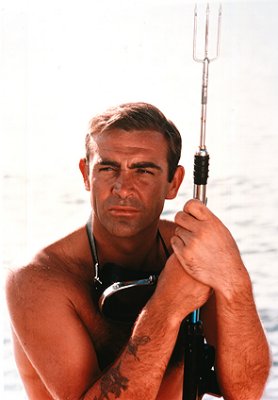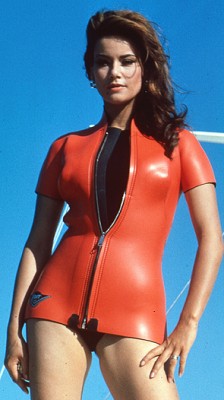
Later this year will mark the 50th birthday of Thunderball (1965), Sean Connery’s fourth movie as James Bond, a smash-hit film at the box-office which in many ways took ‘Bondmania’ to new and dizzying heights in the mid-1960s. One of the main teaser posters for Thunderball said it all: ‘Look Out! Here Comes The Biggest Bond Of All!’
To help celebrate this year’s special fiftieth anniversary of the fourth EON James Bond film – and as the first of a number of upcoming items from us on Thunderball – the JBIFC looks back on some of the familiar and less familiar production aspects of Connery’s fourth adventure as Ian Fleming’s iconic secret agent.
What did it take to get the movie made and up on the big screen? What were the main challenges EON faced? Our brief retrospective celebration is arranged under (00)7 bullet points.
001: The 1965 EON film was based on Ian Fleming’s 1961 novel Thunderball, a book which the Bond author had based on a screen treatment originally developed by himself, Kevin McClory and Jack Whittingham. Fleming’s novel had introduced his many readers to the criminal organisation SP.E.C.T.R.E. for the first time, a syndicate run by Ernst Stavro Blofeld. The EON Bond producers, Albert ‘Cubby’ Broccoli and Harry Saltzman, had originally considered making Thunderball their first 007 movie, but a complex legal dispute (started by McClory) had broken out concerning Ian Fleming’s use of the Fleming-McClory-Whittingham material, so the two EON producers opted for Dr. No as their first 007 adventure instead. Interestingly, though, SP.E.C.T.R.E. was retained for the first EON James Bond movie, partly as an act of defiance against McClory and his ownership claims.
002: For their fourth James Bond movie, however, Broccoli and Saltzman came to a surprise agreement with Kevin McClory, who had won his High Court case against Ian Fleming in November, 1963, and had been awarded certain film and TV rights to the original Thunderball material. The negotiations with EON were actually initiated by McClory. Although he had started work on his proposed screen version of Thunderball in January, 1964, by September that year McClory had come to realise how difficult it would be to make a Bond movie without Sean Connery, and so put out some feelers to EON. At the invitation of McClory, Cubby Broccoli flew out to Ireland to see him and the final deal was apparently struck at Dublin Airport. When asked why they had eventually made the deal with McClory, Broccoli said later: ‘We didn’t want anyone else to make Thunderball. We had the feeling that if anyone else came in and made their own Bond film, it would have been bad for our series’. McClory became producer on the movie, and Broccoli and Saltzman became executive producers. The Irish producer also agreed not to try and make his own Bond movie using his Thunderball rights for at least another 10 years.
003: Guy Hamilton, who had directed Goldfinger (1964), was offered the same job on Thunderball, but turned it down, saying he felt (at that point) ‘drained of ideas’ and wanted to re-charge his creative batteries. The producers then turned back to Terence Young, who had helmed the first two Bond movies so successfully. Young himself also had mixed feelings about returning to Bond, but eventually agreed. He quickly realised, though, the sheer scale of the movie and the big technical challenges it would entail, with its numerous underwater and other sequences, and he recruited three second-unit directors to help him out. Kevin McClory also proved to be very helpful at times, offering his own underwater expertise, making location contacts, and helping to procure the latest diving equipment available.
004: After the huge success of Goldfinger, the new 007 movie was given a budget of $5.6m, an enormous sum at the time and approx. six times the cost of Dr. No. Everything about Thunderball seemed ‘big’. The fourth EON film had a long 18-week shooting schedule for the principal photography, which began in February, 1965, on location in France. Shooting there started on the pre-credits sequence outside the chapel of the Chateau D’Anet, a large and impressive mansion which had been discovered by the ever-resourceful Harry Saltzman, located approx. 40 miles to the west of Paris. According to the late stuntman Bob Simmons, who doubled as the veiled widow in the opening scenes, a large convoy of covered trucks, with Bond’s Aston Martin and a Lincoln Continental (the latter flown in from England), descended on the location and took over the local hotels. The only two pilots qualified to fly the Bell Textron jet pack were also flown to France for the scenes. The logistics were already proving a challenge, and would be just a foretaste of things to come. Indeed, as Simmons also commented, ‘the emphasis on Thunderball was size’.
005: According to some reports, Terence Young became increasingly disenchanted with the film during its final weeks of principal photography; he actually left the movie as soon as all the main shooting was finished (the principal photography was completed at Pinewood in May, 1965). This created a serious and major post-production challenge in itself: so much footage had been taken for Thunderball that the rough first-cut ran to an epic 270 minutes! Editor Peter Hunt (in a sense) rode to the rescue again; he agreed to radically restructure some parts of the movie and cut it down, including removing a key sequence where Largo shows Bond around the Disco Volante. But Hunt made it clear to United Artists that all this would take time and that the World Premiere of the movie, scheduled for October 21st, 1965, at the Odeon Leicester Square, would have to be delayed. The fourth Bond film eventually opened in December, 1965, first in Japan and America, and only then in the UK. Its British premiere had to take place at two cinemas in the British capital, the London Pavilion and the smaller-sized Rialto.
006: A large number of actresses were looked at for the four main female roles in Thunderball (some reports suggest up to 40 women were auditioned and screen-tested). It cost £10,000 (again, a princely sum in the 1960s) just to audition the 40 women and further narrow down the list. A considerable number of these (possibly up to 22) were considered for the key role of Dominique (‘Domino’) Derval, including Julie Christie, Faye Dunaway, Luciana Paluzzi, Yvonne Monlaur, Marisa Menzies, Gloria Paul and Maria Buccella, to name just a few. Raquel Welch was actually offered the role at one point and even signed a contract, but Cubby Broccoli (apparently as a favour to Richard Zanuck at Twentieth Century Fox) reluctantly released her from the contract so that she could appear in the sci-fi movie Fantastic Voyage (1966). The role of Domino finally went to a former Miss France of 1958, 23-year old Claudine Auger, while the Italian actress Luciana Paluzzi was given the equally important role of SP.E.C.T.R.E. assassin Fiona Volpe.
007: Speaking to the press in February, 1965, Sean Connery seemed very keen to start work. He commented: ‘Thunderball is the best story of them all, really. There are wonderful underwater sequences in the Bahamas and the premise is wildly exciting. I think it could be even better than the last one, but I can’t see the cycle going on past that. Though I am signed to do two more – OHMSS and one other’. Two days later Sean flew to France to start work on the new movie, but also stopped off for the Paris premiere of Goldfinger. However, while driving in his DB5 to help publicise the third Bond film in the French capital, the over-excited crowds ran after Connery and the DB5, which must have been quite unsettling. And, again, this was just a glimpse of what lay ahead: relentless press intrusions and intense public interest began to haunt Connery throughout the making of Thunderball, including outside his house in West London and on location in the Bahamas. When this was combined with the long shooting schedule, it left the Scottish 007 star more and more restless. It was also clear that his marriage to Diane Cilento was in trouble. Connery increasingly hinted that the next James Bond film would be his last.
Did You Know?
Claudine Auger told the UK’s Daily Mail in 1965 that the ‘Bond women are women of the nuclear age’, and she was keen to show people she had plenty of brains as well as beauty, with a wide range of skills. Auger surprised people when she turned out to be a crack shot with a pistol, something she demonstrated the day she visited the French police training college near Paris. To the delight of the watching police officers, when it was offered she took a heavy handgun and scored three direct hits on a target!

